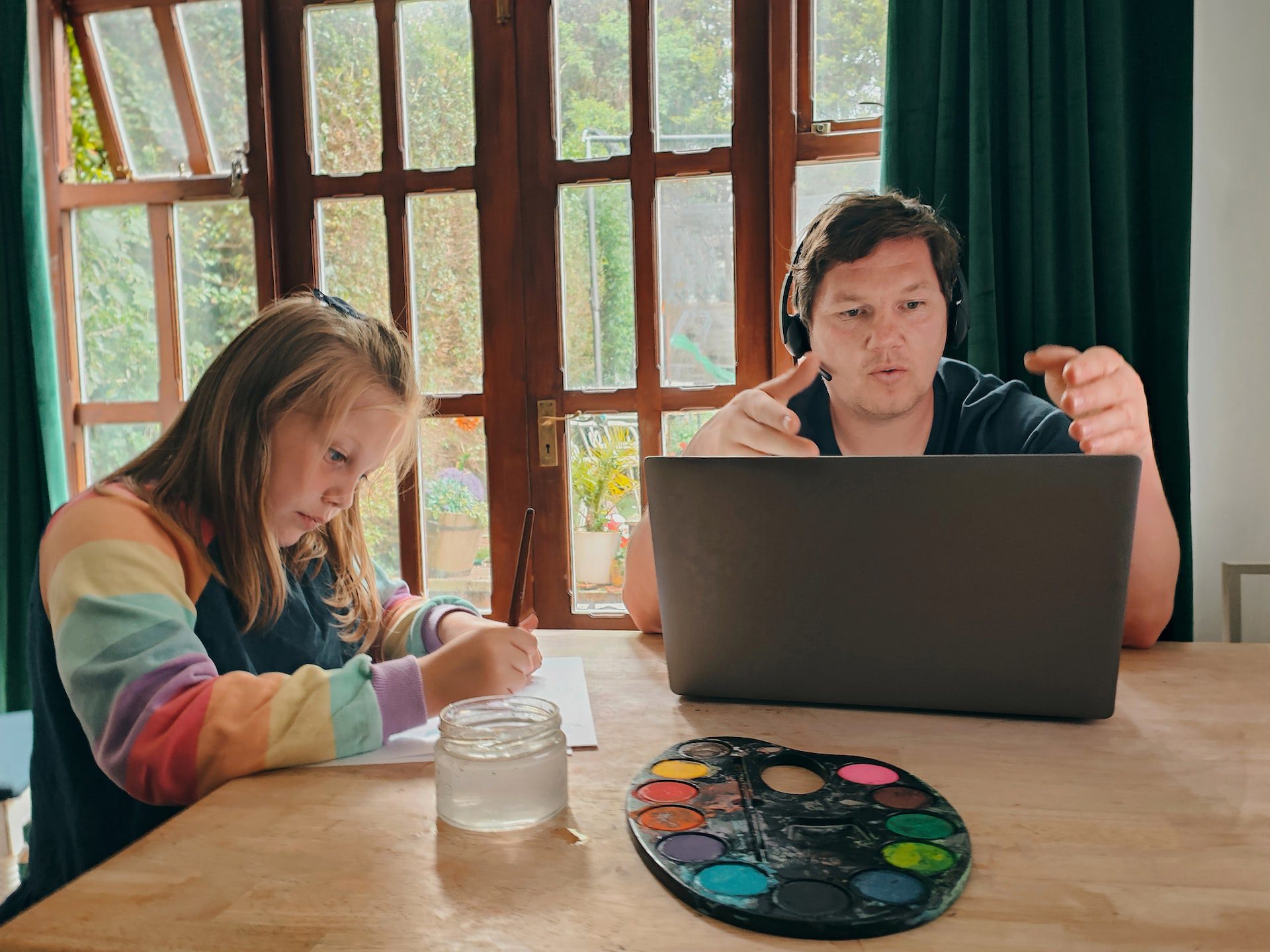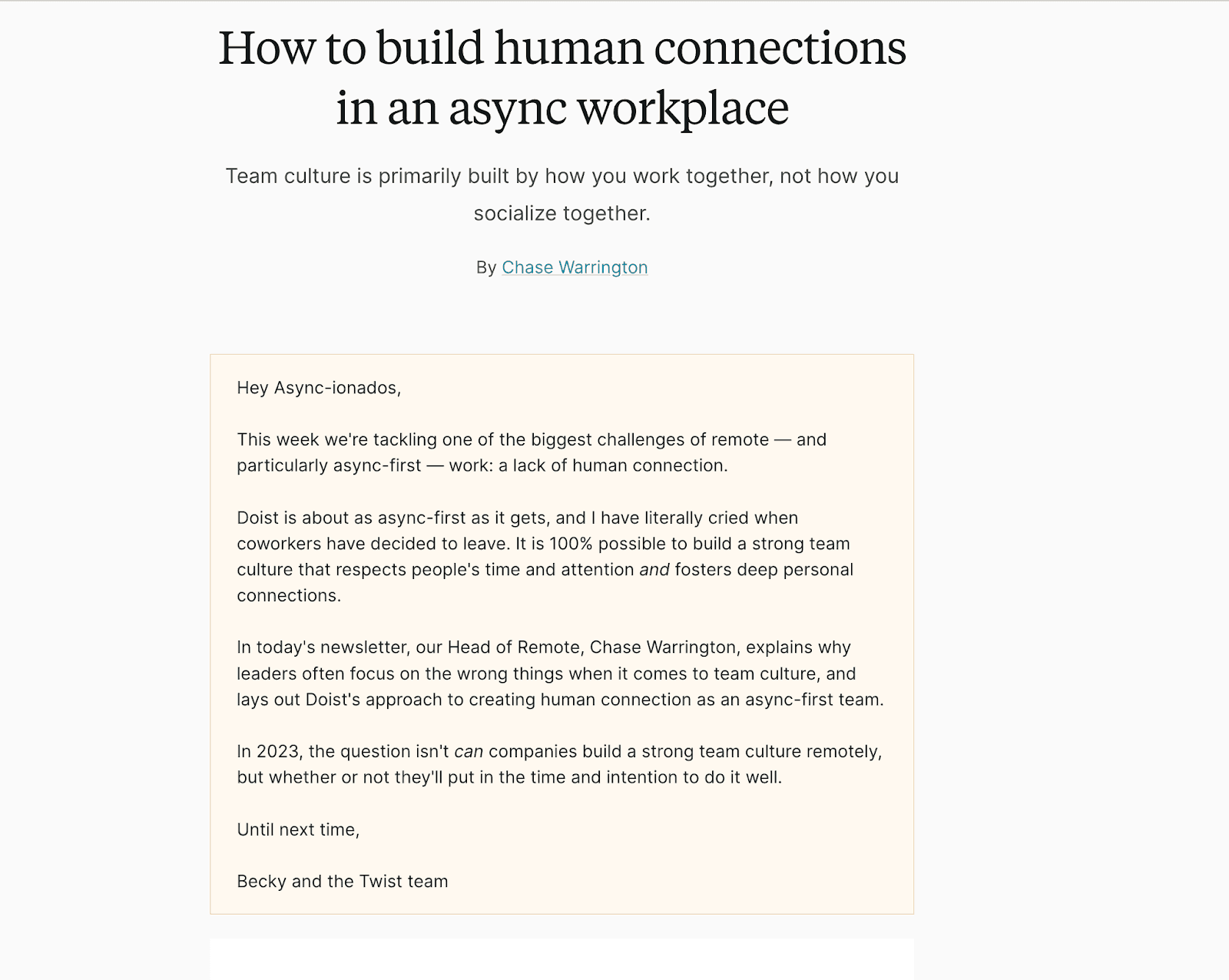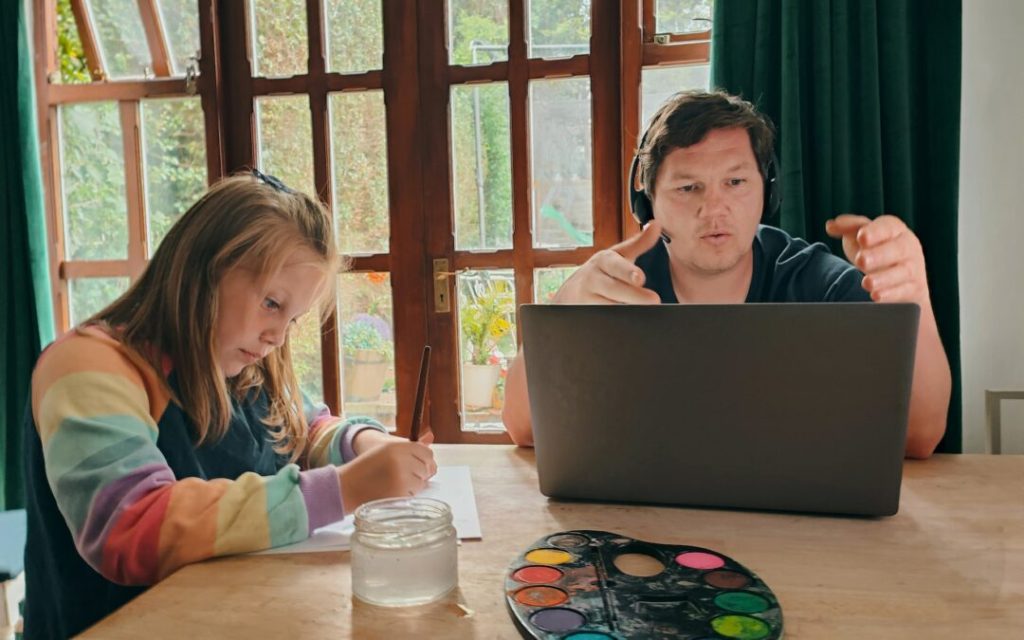To build human connections in the remote workplace, prioritize regular video calls and encourage casual conversations. Foster a culture of open communication and empathy.
Remote work has transformed how we connect with colleagues. Building human connections in a virtual environment can be challenging yet achievable. Prioritizing regular video calls helps maintain face-to-face interaction, making conversations more personal. Encouraging casual chats, even through instant messaging, can mimic office small talk and foster relationships.
Creating a culture that values open communication and empathy ensures everyone feels heard and supported. Virtual team-building activities also play a crucial role in strengthening bonds. By focusing on these strategies, remote teams can stay connected and work harmoniously, despite physical distances.
Importance Of Human Connections
Human connections are essential in the remote workplace. These connections help build trust, foster teamwork, and create a sense of belonging. Without strong human connections, employees may feel isolated and less motivated.
Boosting Morale
Boosting morale is crucial for any team. A happy team works better. Simple gestures, like virtual coffee breaks, can lift spirits. Recognize achievements in team meetings. Send personalized thank you notes. These actions make employees feel valued and important.
Enhancing Collaboration
Human connections enhance collaboration. When people feel connected, they share ideas more freely. Use video calls to foster face-to-face interactions. Create virtual brainstorming sessions. Encourage team members to share their thoughts. This leads to better solutions and innovative ideas.

Credit: andysto.com
Challenges In Remote Work
Remote work offers flexibility and convenience. Yet, it presents unique challenges. These challenges often impact the quality of human connections in a remote workplace.
Isolation
Isolation is a major challenge in remote work. Employees often feel disconnected from their colleagues. This lack of interaction can lead to loneliness. It can also affect mental health. In an office, casual chats are common. They help build relationships. Remote workers miss out on these interactions.
To combat isolation, companies can create virtual lounges. These are online spaces for casual conversations. Scheduled virtual coffee breaks also help. Employees can join video calls just to chat. These small steps can reduce feelings of isolation.
Communication Barriers
Communication barriers are another significant issue. Misunderstandings occur more often in remote settings. This is due to the lack of face-to-face interaction. Body language and facial expressions are missing. This makes it hard to gauge a colleague’s tone or mood.
Using multiple communication tools can help. Video calls are more effective than emails for complex discussions. Instant messaging tools like Slack allow quick clarifications. Clear and concise messages are essential. Over-communication is better than under-communication in a remote setup.
| Challenge | Solution |
|---|---|
| Isolation | Virtual lounges, scheduled coffee breaks |
| Communication Barriers | Multiple communication tools, clear messages |
Remote work challenges require thoughtful solutions. With the right strategies, you can build strong human connections.
Leveraging Technology
In today’s remote workplace, building human connections is vital. Leveraging technology helps bridge the gap. Here’s how you can use technology to create meaningful interactions.
Video Conferencing
Video conferencing is a powerful tool for remote teams. It brings face-to-face interactions into your daily routine. Use platforms like Zoom, Microsoft Teams, or Google Meet.
- Schedule regular meetings to stay connected.
- Use video for team-building activities.
- Encourage cameras on to foster personal connections.
Seeing each other’s faces builds trust and understanding. It also reduces the feeling of isolation among team members.
Instant Messaging
Instant messaging keeps the team connected in real-time. Platforms like Slack, Microsoft Teams, or WhatsApp are excellent choices.
| Platform | Features |
|---|---|
| Slack | Channels, Direct Messages, Integrations |
| Microsoft Teams | Chats, File Sharing, Video Calls |
| Groups, Voice Messages, Media Sharing |
Instant messaging helps in quick communication. It also allows for casual conversation, which is vital for team bonding.
- Create channels for different projects.
- Have a casual chat channel for non-work discussions.
These steps make communication seamless and foster a sense of belonging.

Credit: www.facebook.com
Building A Virtual Culture
Creating a strong virtual culture is vital for remote teams. It helps employees feel connected and engaged. A positive culture can boost morale and productivity. Here are some effective ways to build a virtual culture.
Team Building Activities
Team building activities are essential for any remote team. These activities foster teamwork and collaboration. They also help in creating a sense of belonging.
| Activity | Description |
|---|---|
| Virtual Escape Rooms | Teams solve puzzles to “escape” from a virtual room. |
| Online Trivia Games | Teams compete to answer questions correctly. |
| Virtual Happy Hours | Teams gather online to chat and unwind. |
Virtual Coffee Breaks
Virtual coffee breaks are a great way to connect. They allow employees to chat casually. This helps in building personal relationships.
Scheduling regular coffee breaks can make a big difference. Here are some tips for successful virtual coffee breaks:
- Keep them informal and relaxed.
- Encourage employees to share personal stories.
- Use video calls to make it more personal.
These activities and breaks can help build a strong virtual culture. They make remote work more enjoyable and connected.
Effective Communication Strategies
Building human connections in a remote workplace is challenging. Effective communication strategies can bridge this gap. These strategies ensure everyone feels connected and valued. Here’s how you can foster better communication in your remote team.
Regular Check-ins
Regular check-ins are vital. They keep everyone on the same page. Use video calls for a personal touch.
- Weekly meetings: Schedule weekly team meetings.
- Daily stand-ups: Short daily meetings for quick updates.
- One-on-ones: Personal meetings between managers and team members.
Consistency is key. Ensure these check-ins happen regularly. Use tools like Zoom or Microsoft Teams.
Clear Expectations
Clear expectations prevent misunderstandings. Everyone should know their responsibilities. This includes deadlines and deliverables.
| Aspect | Details |
|---|---|
| Roles | Define each team member’s role clearly. |
| Deadlines | Set clear deadlines for tasks. |
| Communication channels | Specify which tools to use for communication. |
Document these expectations. Share them with the team. Update them as needed.
Good communication builds strong human connections. Use these strategies to improve your remote workplace.
Encouraging Social Interactions
Building human connections in a remote workplace is crucial. Encouraging social interactions can help foster a sense of community. These interactions also combat feelings of isolation. Here’s how to promote social interactions effectively.
Online Social Events
Online social events can bring teams closer. They mimic the casual interactions of a physical office. Consider organizing these events regularly:
- Virtual Coffee Breaks: Schedule short breaks where team members can chat.
- Game Nights: Host online games like trivia or Pictionary.
- Lunch & Learn: Share knowledge over a virtual lunch.
Use video conferencing tools for these events. Encourage everyone to participate. These events can strengthen team bonds.
Peer Recognition
Peer recognition plays a vital role in building connections. It promotes a positive work environment. Here are some ways to incorporate peer recognition:
- Shout-Outs: Create a channel for giving shout-outs to colleagues.
- Awards: Monthly awards for outstanding contributions.
- Feedback: Encourage sharing positive feedback openly.
Recognizing efforts boosts morale. It also creates a culture of appreciation. Use tools like Slack or Microsoft Teams for this purpose.
| Method | Description | Tools |
|---|---|---|
| Virtual Coffee Breaks | Informal chats during short breaks | Zoom, Google Meet |
| Game Nights | Interactive online games | Houseparty, Kahoot |
| Lunch & Learn | Knowledge sharing sessions over lunch | Teams, Slack |
| Shout-Outs | Public recognition for achievements | Slack, Teams |
| Awards | Monthly awards for contributions | Company intranet |
| Feedback | Sharing positive feedback openly | Email, Teams |
Creating A Supportive Environment
Creating a supportive environment in the remote workplace is essential. It fosters trust, collaboration, and well-being among team members. Providing the right resources and policies can significantly enhance the remote work experience.
Mental Health Resources
Offering mental health resources is vital. Employees face unique challenges when working remotely. Ensure they have access to professional support. This includes virtual counseling, therapy sessions, and wellness programs.
- Virtual counseling sessions
- Online therapy options
- Mental wellness programs
Encourage employees to use these resources. Normalize mental health discussions. This creates a more open and supportive atmosphere.
Open Door Policy
An open door policy can greatly benefit a remote team. It promotes transparency and open communication. Managers should be approachable and available to their team members.
- Set up regular check-ins
- Use instant messaging tools
- Encourage feedback and suggestions
Use technology to maintain an open door. Video calls and chat platforms can bridge the gap. This ensures everyone feels heard and valued.

Credit: coschedule.com
Measuring Success
Measuring success in building human connections in the remote workplace is crucial. It helps understand the impact of your efforts. We will explore two key areas: Employee Feedback and Performance Metrics.
Employee Feedback
Gathering employee feedback is vital. It provides insights into how well connections are being made. Regular surveys can help.
- Conduct anonymous surveys for honest feedback.
- Use tools like Google Forms or SurveyMonkey.
- Ask specific questions about their feelings of connection.
Consider holding virtual focus groups. Discuss the challenges and successes. This gives a deeper understanding of their experiences.
| Question | Response Scale |
|---|---|
| Do you feel connected to your team? | 1 (Not at all) – 5 (Very much) |
| How often do you communicate with your team? | Daily, Weekly, Monthly |
Performance Metrics
Tracking performance metrics helps measure success objectively. Look at team productivity and engagement.
- Monitor project completion times.
- Check the number of collaborative tasks.
- Evaluate the frequency of team meetings.
Use tools like Trello or Asana. They help track project progress. Compare metrics before and after implementing connection strategies.
Another key metric is employee retention rates. High retention often means strong connections. Happy employees are less likely to leave.
Frequently Asked Questions
How Can I Foster Teamwork Remotely?
To foster teamwork remotely, use collaborative tools like Slack and Zoom. Schedule regular virtual meetings and team-building activities. Encourage open communication and provide clear goals.
What Are Effective Ways To Communicate Remotely?
Effective remote communication involves using video calls, instant messaging, and email. Set clear expectations, regularly check in, and use collaborative platforms for project management.
How Do I Build Trust In A Remote Team?
Build trust by being transparent, reliable, and consistent. Encourage open communication and provide regular feedback. Recognize and reward team members’ efforts.
How Can I Create A Sense Of Belonging Remotely?
Create a sense of belonging by organizing virtual social events. Celebrate achievements, encourage inclusivity, and maintain regular, casual check-ins with team members.
Conclusion
Building human connections in a remote workplace is essential. Utilize video calls, encourage open communication, and prioritize team bonding. These strategies foster a supportive work environment. Strong relationships lead to increased productivity and job satisfaction. Implement these tips to create a cohesive and connected remote team.

